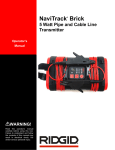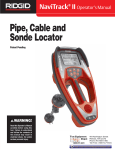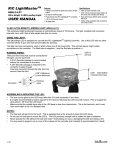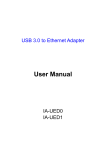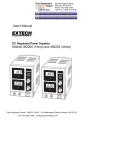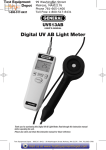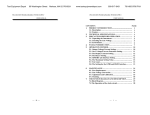Download Using the NaviTrack FloatSonde™
Transcript
NaviTrack FloatSonde User Manual Using the NaviTrack FloatSonde™ The NaviTrack FloatSonde™ is a small, powerful, battery powered device that transmits a 512Hz signal to be picked up by the NaviTrack Sonde and Line Locator. When introduced to a drain or sewer line from a suitable access point, the unit floats and/or rolls freely down the line. Figure 2 – a string may be attached to the ring on the bottom of the transmitter for retrieval. Features • • • • • Flushable Simple, one-button operation LED operation indicator Integrated retrieval hook Operates up to 10 hours on two user-replaceable CR2032 batteries Specifications Size: ∅40mm (∅1.57”) Weight: 27g Red status LED Operating Frequency: 512Hz Frequency Tolerance: +/- 0.00005Hz Figure 1 – to turn the transmitter ON, press down firmly on the top of the transmitter’s housing. The LED will illuminate. Keep pressing until the LED begins flashing. To turn the transmitter OFF, press and hold until the LED stops flashing. During operation of the sonde, the LED will continue to flash. Typical maximum detection range in air with NaviTrack receiver (varies with ambient noise and interference): 10 ft 99 Washington Street Melrose, MA 02176 Phone 781-665-1400 Toll Free 1-800-517-8431 Visit us at www.TestEquipmentDepot.com NaviTrack FloatSonde User Manual Locating the NaviTrack FloatSonde™ The FloatSonde is weighted to position its core vertically in order to produce a stronger signal for locating. Because of the altered orientation, the procedure for locating the FloatSonde differs from that of a conventional sonde, which has a horizontal core. When locating with a horizontal sonde, a NaviTrack receiver sees two poles and an equator. (Fig. 1) When locating the FloatSonde, only one pole is ‘visible’. The equator and second pole cannot be seen above ground. (Fig. 2) equator pole pole pole Fig. 1 Fig. 2 Under normal conditions, the sonde will be located directly below the pole, and the pole will be located at the point of highest signal strength. If the pole and highest signal strength are not located at the same point, the sonde is tilted. (Fig. 3) Fig. 3 Locating a tilted FloatSonde is similar to locating a horizontal sonde. The equator and possibly the second pole will be visible, depending on the angle of tilt. A tilted sonde, however, will not be located directly below the pole, or the equator. The FloatSonde can still be located by finding the point of maximum signal strength. Test Equipment Depot - 800.517.8431 - 99 Washington Street Melrose, MA 02176 TestEquipmentDepot.com NaviTrack FloatSonde User Manual Changing FloatSonde Battery Cells 1. Remove tape (Properly engaged o-ring) 2. Apply light pressure at equator of sonde with pliers to disengage snap. 5. Fit internal assembly to supports on top shell. 3. Replace both CR2032 battery cells 6. Snap shells together and apply new tape around equator. 4. Return o-ring to its proper place in top shell. Test Equipment Depot - 800.517.8431 - 99 Washington Street Melrose, MA 02176 TestEquipmentDepot.com



